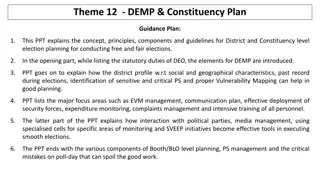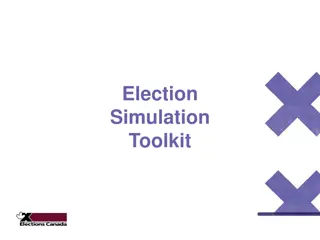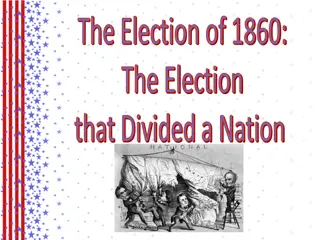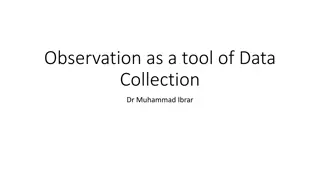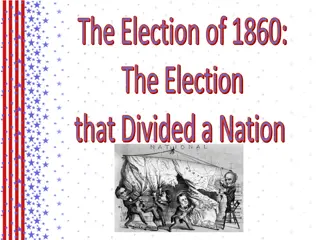Importance of Gender in Democratic Election Observation
Understanding the significance of gender in democratic elections, this content delves into the objectives of gender inclusion in election observation. Key terms such as gender, sex, equality, and equity are explored, highlighting the barriers women may face in the electoral process. Through the lens of election observation, the content emphasizes the need for women's equal participation in various election phases including as voters, candidates, administrators, and observers. It discusses strategies to incorporate gender in Parallel Vote Tabulations and evaluates the quality of women's participation in elections to ensure inclusivity and transparency.
Download Presentation

Please find below an Image/Link to download the presentation.
The content on the website is provided AS IS for your information and personal use only. It may not be sold, licensed, or shared on other websites without obtaining consent from the author.If you encounter any issues during the download, it is possible that the publisher has removed the file from their server.
You are allowed to download the files provided on this website for personal or commercial use, subject to the condition that they are used lawfully. All files are the property of their respective owners.
The content on the website is provided AS IS for your information and personal use only. It may not be sold, licensed, or shared on other websites without obtaining consent from the author.
E N D
Presentation Transcript
Gender and Election Observation: Election Day Observation and Parallel Vote Tabulations Gender, Women and Democracy NDI, 2016
GENDER AND ELECTION OBSERVATION: OBJECTIVES Understand why gender is important for a democratic election Identify potential barriers to women s participation in the electoral process Understand specific ways to incorporate gender into a Parallel Vote Tabulation (PVT), including training, checklists and reporting
KEY TERMS Gender Sex Gender equality Gender equity
WHY INCLUDE GENDER IN ELECTION OBSERVATION Democratic elections should be inclusive, transparent and accountable. Inclusive elections are ones that enable both men and women to participate (50/50). The principle of inclusion is not only about enabling but also about taking positive action to address particular barriers women might face.
WHY INCLUDE GENDER IN ELECTION OBSERVATION Domestic observers should assess the quality of women s participation in each stage of the electoral process - including on election day - as part of their assessment of the quality of the election. As a tool to systematically collect data on election day, PVTs present a key method for evaluating equal and genuine opportunity for women to participate as voters and election workers.
WHY INCLUDE GENDER IN ELECTION OBSERVATION Democratic elections must include equal participation by women in every phase of the process, including as: Voters Candidates Election administrators Observers Women s participation can be measured through a combination of long-term observation and PVT.
ELECTION OBSERVATION: WOMEN AS CANDIDATES Observing inclusiveness in elections involves paying attention to norms and practices that affect equity in men s and women s ability to run for public office and can include: Electoral systems Political party practices Political-electoral financing systems Traditional and social media coverage
ELECTION OBSERVATION: ELECTION ADMINISTRATION Assess the number of women in election administration: How many women are in leadership and decision-making roles at polling stations? Women should have the ability to participate as election observers, commission members, poll workers, etc. Assess the election administration s awareness of barriers for women. Gauge the responsiveness of administrators to any related issues that may arise on election day. Picture Source: ACE Project
ELECTION OBSERVATION: WOMEN AS VOTERS Observing the inclusiveness of voting requires assessing whether men and women have equal access to: Voting locations Voting and verification processes Complaint processes This includes recording and analyzing incidents of threats, intimidation or actual violence against women voters at polling stations.
ELECTION OBSERVATION: WOMEN AS VOTERS Women can face significant barriers to participation as voters. These barriers can be: Physical Legal Logistical Historical or traditional Social or cultural Picture Source: NDI
ELECTION DAY: WHAT TO OBSERVE OR ASSESS Is the polling station safe? Secure? Accessible? How many women are on the polling station committee? What sex is the chairperson of the committee? Do women voters understand procedures? Is sex disaggregated voter data available? Are women disproportionately affected by problems with the voting process?
ELECTION DAY: WHAT TO OBSERVE OR ASSESS Are there instances of violence against voters or workers? If yes, what kinds? Of the voters turned away, how many are women? Is the secrecy of the vote protected? Are there instances of family or proxy voting? What are the voter rates, both at central and regional levels?
PARALLEL VOTE TABULATION (PVT)
PVT: WHAT ARE WE MEASURING? What are the important criteria for election day? Participatory: All eligible voters have a genuine opportunity to freely work or observe an election and cast their vote. Accountable: Procedures are followed to ensure the secrecy of the ballot, prevent illegal voting and reflect the will of the voters individually - not their parties or families. Transparent: Citizens (women and men) have the right to be present (for example, as observers or party poll watchers) from the time the polling station is preparing to open until it closes.
PVT: METHODOLOGY PVTs require a different approach from long term observation and therefore include different types of questions. PVTs provide a unique way to observe the integrity of the electoral process, and a way to cross-check data using a long-term observation which allows for more systematic data collection
PVT: WHAT CAN IT MEASURE? Percentage of election officials who are women The gender of the polling station president or supervisor Percentage of women representing parties or candidates as poll watchers The percentage of women observers The atmosphere around the polling stations and general security environment Incidents of threats and intimidation to influence or stop women from voting
PVT: WHAT CAN IT MEASURE? Percentage of women among voters who were refused or turned away from the polling station The secrecy of the ballot and any cases of assisted voting, proxy voting or family voting Cases of sexual violence against voters, observers or party poll watchers Cases of physical violence against women
PVT: WHAT CAN IT MEASURE? A PVT can provide important information about an incident, especially through the use of a critical incident form: Date and time Type of violence Harassment, intimidation, physical violence, sexual violence, etc. Perpetrator(s) of violence, including gender and affiliation Victim(s) of violence, including gender and affiliation Motivation for the violence Impact of the violence
THANK YOU Picture Source: NDI





